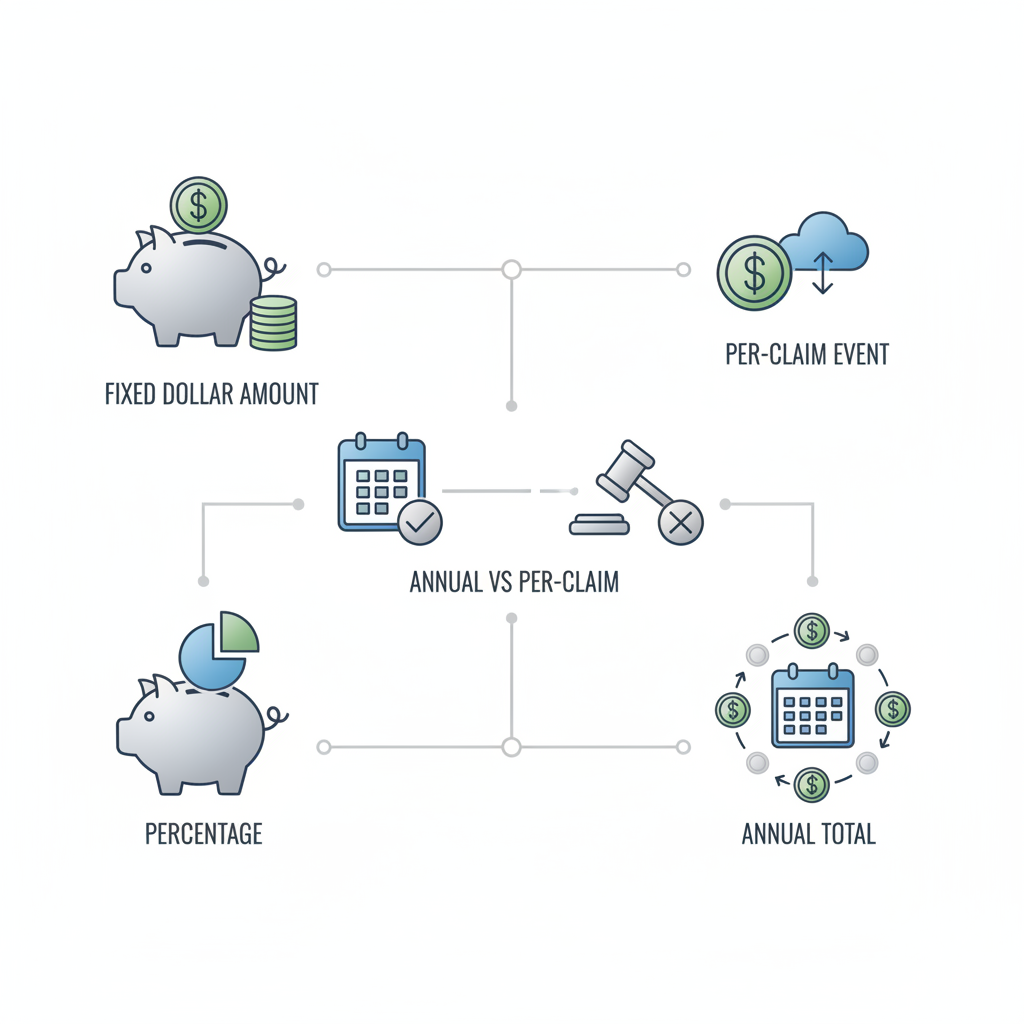
Table of Contents
Introduction
Understanding the ins and outs of your insurance deductible can feel like navigating a complex maze. What exactly is a deductible, and why does it matter so much when you’re managing your insurance policy? Whether you’re buying a new policy or reviewing your current coverage, gaining clarity about deductibles is essential to making informed decisions that protect your finances without surprises.
Insurance policies often include a deductible, which is the amount you must pay out of pocket before your insurer starts covering expenses. This mechanism plays a critical role in how your policy functions, impacting not only your claim experience but also your premium costs. Many policyholders understandably find deductibles confusing, yet understanding this concept can empower you to choose insurance that aligns with your financial situation and risk tolerance effectively.
Imagine facing a car accident or property damage and realizing that your deductible determines how much you pay before insurance kicks in. The stakes are high, and lacking insight into deductibles can lead to unexpected out-of-pocket expenses at stressful times. With the right knowledge, you can anticipate these costs, plan accordingly, and avoid financial strain when claims arise.
It’s important to know that deductibles vary widely among different types of insurance—including auto, home, and health insurance—and the structure of these deductibles can influence your overall coverage experience. Building your understanding starts with the basics, and if you’re new to insurance concepts, exploring general insurance basics will provide a solid foundation to help you make confident choices. This guide will break down what deductibles are, why they matter, and how to select the right one for your needs with expert tips and detailed examples.
What You’ll Learn in This Guide
In this comprehensive guide, we’ll walk you through everything you need to know about insurance deductibles. Here’s what you can expect to learn:
- Understanding the Basics: You’ll learn what an insurance deductible is, including the different types such as fixed amounts, percentages, annual, and per-claim deductibles. This foundational knowledge is crucial for grasping how deductibles impact your insurance coverage.
- How Deductibles Affect Your Policy: This section explains the relationship between deductibles, premiums, and claims. You’ll see real-world examples that illustrate how different deductible levels influence your financial responsibility and insurance payout.
- Choosing the Right Deductible: Learn how to select a deductible amount that suits your financial situation and risk tolerance. This includes understanding the trade-offs between higher and lower deductibles and their effects on your premiums and out-of-pocket costs.
- When to Contact Your Insurer: Discover key situations where reaching out to your insurance provider is beneficial, such as changing your deductible, understanding claims, or clarifying policy details to ensure you’re always informed and properly covered.
As we continue, we’ll explore each of these points in clear, practical language, so you feel empowered to navigate your insurance deductible confidently. Whether you’re reviewing an existing policy or purchasing new insurance, understanding these details will help you avoid surprises and optimize your coverage to fit your lifestyle and needs.
This guide is designed to be your go-to resource for mastering the often-overlooked but crucial component of insurance policies: the deductible. You’ll find expert insights, helpful examples, and actionable advice that can save you money and provide peace of mind when the unexpected happens.
By the end of this article, you will have a clear understanding of how deductibles work and how to make decisions that improve your financial protection. Let’s dive in and unlock the knowledge you need for smarter insurance choices and greater confidence in your coverage.

Understanding insurance deductibles is essential for anyone looking to make informed decisions about their insurance policies. After the introduction to what a deductible is and why it matters, let’s delve deeper into the mechanics and significance of deductibles. These elements not only influence how much you pay out of pocket during a claim but also affect your overall insurance premiums and the risk-sharing dynamics between you and your insurer. This discussion will help you navigate the complexities and empower you to choose the right deductible that aligns with your financial situation and coverage needs.
The Mechanics and Types of Insurance Deductibles
Insurance deductibles serve as a critical aspect of most policies, acting as a specified amount that policyholders must pay before their insurer contributes to a claim. Deductibles vary greatly across different insurance types such as health, auto, and home insurance, and they come in several forms. Understanding the different types of deductibles helps clarify how your financial responsibility is structured in the event of a claim. Exploring this concept provides the foundation needed to appreciate the broader implications of how deductibles work within insurance coverage.
Typically, deductibles are categorized broadly into fixed dollar amount deductibles and percentage deductibles. Fixed deductibles require the insured to pay a set amount, for example, $500 per claim before insurance covers additional costs. In contrast, percentage deductibles calculate the deductible as a percentage of the insured value, which might be seen in certain homeowner policies. Additionally, deductibles can be annual or per-claim: annual deductibles accumulate over a policy year, while per-claim deductibles apply separately for each claim filed. This structure impacts not only how often you might have to pay out-of-pocket costs but also influences your financial planning when managing claims.
Key Aspects of Deductibles
The following points highlight the crucial features and variations of insurance deductibles that every policyholder should understand:
- Fixed Dollar Amount Deductibles: These are straightforward and easy to understand, requiring a lump sum payment for each claim. For example, if you have a $1,000 deductible and file a claim, you must cover the first $1,000 of costs before insurance pays the rest. This type is common in auto and health insurance policies.
- Percentage-Based Deductibles: Instead of a set amount, this deductible is a percentage of the insured amount or the loss. It’s often used in property insurance and is particularly relevant when substantial asset values are involved, such as home insurance in disaster-prone areas.
- Annual vs. Per-Claim Deductibles: An annual deductible means you pay a total deductible amount once per year, regardless of how many claims you file. Per-claim deductibles require paying the deductible each time a claim is made, which may increase out-of-pocket expenses if multiple claims occur frequently.
- Impact on Premiums: Deductibles directly influence the cost of your insurance premium. Generally, a higher deductible results in lower premiums as you agree to bear more upfront costs during a claim, while a lower deductible means higher premiums but less immediate cost when making claims.
Choosing the Right Deductible and Its Financial Impact
Selecting an appropriate deductible is a strategic decision that hinges on your financial ability, risk tolerance, and frequency of expected claims. Choosing between lower and higher deductibles essentially balances between monthly premium affordability and potential out-of-pocket expenses during claims. A well-chosen deductible can lead to substantial savings on premiums without exposing you to undue financial risk. This decision also embodies the principle of risk sharing between you and your insurer, highlighting the importance of being well informed about how different deductible levels affect your coverage.
In addition to understanding your personal budget, considering the nature and frequency of your claims is critical. Those who rarely file claims might benefit from a higher deductible to save on premiums, whereas individuals anticipating regular claims may prefer lower deductibles to minimize out-of-pocket costs. It’s also essential to factor in the specific type of insurance coverage you hold. For instance, while a high deductible might work for auto insurance, it could be riskier for health insurance where frequent medical expenses are common. Careful evaluation helps prevent surprises and ensures that you are financially prepared for potential claims.
Important Considerations for Selecting Deductibles
When deciding on your deductible, these key points can help guide your choice:
- Budget for Out-of-Pocket Expenses: Evaluate how much money you can comfortably allocate for deductibles without financial strain. This assessment ensures that in case of a claim, you have enough funds to cover the deductible without compromising your financial stability.
- Frequency of Claims Anticipated: Consider how often you might need to file claims based on your circumstances and risk exposure. Frequent claims necessitate a more cautious approach to deductible amounts to avoid excessive costs.
- Type of Coverage: Different insurance types and policies have unique deductible structures, so understanding the details of your specific coverage is essential. Health, auto, and home insurance policies might each require different approaches to deductible selection.
- Risk Sharing with Insurers: Think of deductibles as a sharing mechanism that balances risk between you and your insurance provider. Higher deductibles mean you shoulder more initial risk, potentially lowering your premiums, whereas lower deductibles shift more risk to the insurer but increase premium costs.

